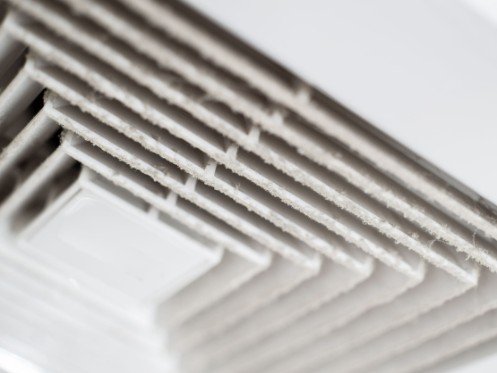According to a diary study by the Environmental Protection Agency (EPA), Americans spend more than 90 percent of their day indoors. And yet, many homeowners don’t realize that our indoor air quality (IAQ) can actually be worse than that outside – 3 to 5 times worse, in fact. Modern homes are much more tightly sealed than those of the past. In some ways, this is good. But it can negatively affect air quality because it doesn’t allow ventilation of harmful chemicals or other volatile organic compounds (VOCs).
Indoor air pollution can cause a variety of health issues, including respiratory issues, dry skin, increased allergies, dizziness, and more. This is even more of a concern if you have people in your home with a compromised immune system, such as young children, elderly, or anyone with an immune deficiency. Keeping an eye out for these signs and symptoms can help you determine if an IAQ system may be a good option for improving your home comfort.
Signs of Poor Indoor Air Quality
Unpleasant Odors
We’ve all had those moments where we come home to an unpleasant odor and find fruit that was left on the counter too long or something rotting at the bottom of the trash can. But if you’ve eliminated those potential causes and can’t find the source of the stench, it’s possible you could be dealing with harmful contaminants like dust or mold, which commonly lead to an unexplained odor in the home. While the best way to determine the source is to have your home inspected, there are some common rules of thumb that may give you an idea of what type of contaminant you’re dealing with.
A musty, damp smell can often mean you have mold growing somewhere in your home, which is a very serious health concern. Mold growth alone can cause extreme fatigue, joint inflammation, depression, and digestive problems. If you notice a musty smell, it’s important to have your home inspected right away.
If you notice an odor similar to dirty socks, you may be dealing with bacterial growth. This can sometimes occur in the heating system coils, which then causes the smell to be dispersed throughout the home while the heater is on. This type of bacterial growth is especially common during the spring and fall when the system is consistently alternating between heating and cooling.
A bitter odor can be a sign of poor ventilation, along with stuffy air and condensation on cold surfaces. Again, our homes are built much more tightly nowadays, and that doesn’t leave much room for contaminants to exit the home.
Humidity
Excess humidity in the home can be a sign of poor air quality. While the humidity itself might seem like a minor issue, it’s typically a precursor to more serious problems, like mold or mildew growth, wood rot, damaged paint or peeling wallpaper, and swelling in the wood structure of your home.
If you notice that you’re dealing with increased humidity during the summer, it may be a sign that your air conditioner isn’t functioning properly. While it may not be the primary function, your AC system does work as a dehumidifier. Too much humidity in the home may mean it’s not working to its full potential; it’s important to have it serviced regularly to extend its lifespan and prevent any major issues with humidity in your home.
Hot and Cold Air Pockets
Inconsistent temperature in your home can indicate poor air circulation, which can create a breeding ground for pollutants and toxins. If you have pockets in your home that are consistently cooler or warmer than the rest of your home, it can indicate problems with your air conditioner or heating system. It’s important to address these issues to ensure your systems are running efficiently (especially in areas that experience extreme heat).
Coughing, Chest Congestion, and Other Respiratory Symptoms
You know your family best and what is normal health-wise for them. While some respiratory symptoms can simply be a sign of seasonal allergies, consistent problems may be a sign of indoor air pollution. This includes coughing, wheezing, chest congestion, stuffy nose, and itchy eyes. Air pollutants that can cause these symptoms include cleaning supplies and household chemicals, bacteria and viruses, dust mites, pet dander, secondhand smoke, and more.
Difficulty Sleeping
When people experience problems sleeping, air pollution is rarely on the list of things they’re worried about. But exposure to indoor pollution can be a much more common cause than many people think. In fact, researchers found that people who live in areas with high air pollution were 60 percent more likely to sleep poorly. While this study focused on outdoor air pollution, it’s still very relevant to IAQ, especially since we know that indoor air pollution can actually be worse.
When people experience sleep deprivation due to pollution, it can lead to numerous health risks, including depressive mood, higher risk of cancer and cardiovascular diseases, and overall lower quality of life.
Allergy Symptoms
Common allergy symptoms can become worse if you’re dealing with poor air quality. Issues like eye irritation, skin irritation, or persistent sneezing can indicate poor air quality in the home, especially if you notice that the symptoms are less frequent when you’re out and about.
Installing an IAQ system can help improve ventilation and minimize air pollutants, giving you a higher quality of life overall.
Excessive Dust Buildup
We tend to think of dust as something we see, not something we breathe. And while a little bit of dust is normal, excessive buildup can seriously impact your health. Small dust particles act as carriers for other toxins, such as phthalates, phenols, and harmful VOCs. When there is too much dust in the home, it becomes a cesspool for harmful contaminants that impact our daily lives.
Mold
A lack of ventilation in the home can lead to humidity buildup, which, as we discussed previously, can be a precursor to mold formation in the home. Mold and mildew have significant health risks. Beyond the extreme fatigue, joint inflammation, depression, and digestive problems discussed previously, mold can cause life-threatening health concerns if left untreated. It will grow anywhere with moisture, such as around leaky roofs, windows, or pipes. It can also grow in paints, wallpaper, insulation, drywall, carpet, fabric, and upholstery.
Dizziness and Fatigue
Certain types of air pollution can lead to symptoms like dizziness and fatigue. While certain VOCs and contaminants can cause this, another concern to look out for is the presence of carbon dioxide in the home. This is produced by gas- and oil-burning surfaces; especially those that are not serviced regularly. Having your furnace inspected annually can help prevent this problem and ensure comfort in your home.
Diagnosing the Cause of Poor Air Quality
Indoor air quality isn’t something we think about often, and knowing whether there are issues in the home can be even more difficult to determine. The good news is that air quality service providers like On Time Experts can help you identify exactly which contaminants are in your air, and how much of them are present. By equipping yourself with that knowledge, you can create a game plan to clean up your IAQ and create a more comfortable and healthy home for your family.

